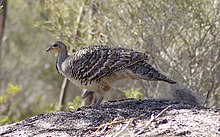Mallee


Mallee is an Australian form of vegetation that covers more than 250,000 square kilometers of Australia . The "scrubs and shrublands" (bushes and bush formations, MVG 14) consist of two to ten meters high eucalyptus bushes. The species known as Mallee have lignotubers , powerful woody rhizomes, and are multi-stemmed.
species
There are around 200 species of Mallee eucalyptus. They form the driest eucalyptus communities and occur most frequently in areas with 200 to 350 mm (130 to 800) of rainfall, especially in Mediterranean climates with winter rain ( zonobiom IV). Single-stemmed eucalyptus dominate when there is more rain, and acacias when there is less. The area in which they occur extends from 117 ° (Western Australia) to 147 ° east longitude, and especially from 25 ° to 36 ° south latitude, and covers around 250,000 km².
The core zone with 250 to 400 mm of precipitation on limestone soil is referred to as a typical Mallee. In the east there are two types of Mallee: the Eucalyptus incrassata type with a species-rich undergrowth of sclerophyllous shrubs in the south-temperate area and the semi-arid, Eremean Mallees with Eucalyptus socialis , Eucalyptus dumosa and others dominated by semi- succulent Chenopodiaceae in the undergrowth . In the west there is a smooth transition from the multi-stemmed Mallees to the single-stemmed Woodlands , especially in the Goldfields area . In drier areas the malls become higher. In general, the malls in the west are higher at the same locations and reach up to 27 meters, while in the east they do not exceed nine meters.
The meaning of the fire in the Mallee
Fire is an important factor in the Mallee . The eucalyptus scatter their seeds especially after fire, while there is no seed bank in the soil. The fire interval in the core area is around 20 years. The lignotuber of the species typical of the Mallee have dormant buds and serve as a carbohydrate store. After bushfires, the plants regenerate from these lignotubers.
Protected areas of this habitat
The habitat of the Mallee is endangered, among other things, by arable farming and the valuation of livestock. It is protected in several Australian protected areas. These include:
- Fitzgerald River National Park
- Stirling Range National Park
- Two Peoples Bay Nature Reserve
- Murray Sunset National Park
- Mallee Cliffs National Park
- Wyperfeld National Park
- Hattah Kulkyne National Park
- Billiatt Conservation Park
- Ngarkat Conservation Park
Bird species of the Mallee

One of the most typical inhabitants of the Australian Mallees is the thermometer chicken , which is called Malleefowl in English . The species is also known for its unusual breeding habits. The rooster of the thermometer chicken digs a pit several meters wide and one meter deep, which is filled with plant material from the immediate vicinity. As soon as the low rainfall has moistened the plant material, the rooster covers it with a layer of sand. The pit stores moisture and the rotting of the plants creates heat in which the eggs are hatched. The rooster monitors the temperature with the help of its beak and regulates the temperature of the hill by scratching up and down the layer of earth.
A number of other bird species are typical of the Mallee. These include:
- Australian bittern ( Botaurus poiciloptilus )
- Mallee bristle tail ( Stipiturus mallee )
- Mallee babbler ( Manorina melanotis )
- Carnaby's white-eared black cockatoo ( Calyptorhynchus latirostris )
- Brown-bellied thicket bird ( Atrichornis clamosus )
- Long-billed lacquer bird ( Dasyornis longirostris )
- Red rein stubborn ( Pachycephala rufogularis )
- Gray-headed rocker flute ( Psophodes nigrogularis )
- Mountain Parakeet ( Polytelis anthopeplus )
- Crimson Honeyeater ( Lichenostomus cratitus )
- Parakeet cap ( Purpureicephalus spurius )
- Yellow-cheeked rosella ( Platycercus icterotis )
- Red-eared Amadine ( Stagonopleura oculata )
Trivia
Mallees often form burl bulbs, which are very popular with knife makers and for turning work because they develop a particularly beautiful grain. The density of the wood that occurs in these burl bulbs is very high (1200-1300 kg / m³). It can therefore be polished very well. Well-known names for this burl wood are: Red Mallee, Brown Mallee, Yellow Box, Coolibah and Goldfield.
literature
- Martin Walters: The signals of birds - What birds reveal about the environment . Haupt, Bern 2011, ISBN 978-3-258-07682-9 .
Web links
- Habit of Eucalypts . In: Euclid . Australian National Botanic Gardens . Retrieved May 6, 2007.
- Mallee woodlands and shrublands (PDF; 305 kB) In: Australian National Resources Atlas . Retrieved May 3, 2013.
Single receipts
- ↑ Martin Walters: The signals of the birds - What birds reveal about the environment . Haupt, Bern 2011, ISBN 978-3-258-07682-9 . P. 86
- ↑ Martin Walters: The signals of the birds - What birds reveal about the environment . Haupt, Bern 2011, ISBN 978-3-258-07682-9 . , P. 87.

